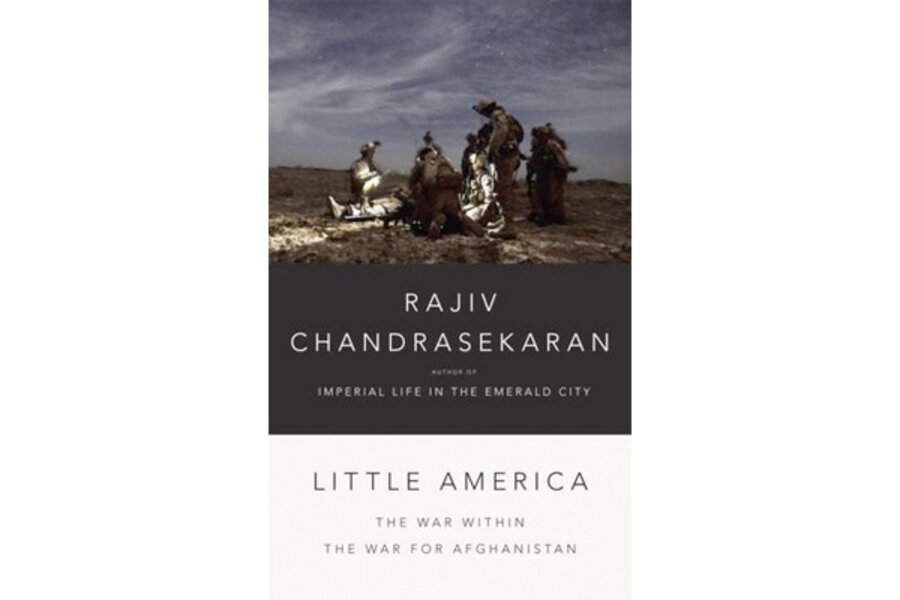Little America
Loading...
Year after year, American journalists risk their lives to enter nations invaded by the United States, hoping to learn the truth about war. During the early years of this century, Washington Post reporter Rajiv Chandrasekaran risked his life traveling throughout Iraq. His excellent reporting exposed the outright lies, half truths and self deceptions being disseminated by President George W. Bush, his civilian government appointees and his military commanders. The reporting resulted in the book “Imperial Life in the Emerald City,” published six years ago.
With the mostly disastrous American presence in Iraq diminishing, Chandrasekaran turned his attention to Afghanistan. His travels there included time spent in combat with the Second Marine Expeditionary Brigade, as well as hanging around command headquarters. His new book, Little America: The War Within the War for Afghanistan, is rough on the Bush administration (again), but even rougher on President Barack Obama, his civilian government appointees, and his military commanders. By any measure, based on Chandrasekaran’s findings, the war has wasted military and civilian lives with almost no positive outcomes.
The title “Little America” is telling, yet probably requires elucidation. It refers to US civilian and military efforts dating to at least the 1940s to turn the rugged, tribal based nation state into something akin to the USA, with thriving agriculture, urban oases, formal education, gender equality and longer life spans. Every American effort at transformation has failed. But lots of otherwise intelligent individuals, including Obama, seem to have learned little from the history of American failure.
The subtitle “The War Within the War for Afghanistan" is telling, too, and also probably needs explanation. The war within the war refers to turf and policy battles among decision makers who should be pulling together. Chandrasekaran’s discerning reporting and vivid writing reveal deadly disagreements between military commanders and civilian political appointees, between US forces and allied forces (especially the British), and so many other permutations that the text of the book sometimes qualifies as mind-boggling. While important people bicker, US soldiers and Afghani soldiers and members of the Taliban “enemy” forces and civilians galore die or are permanently maimed, to no apparent meaningful end.
It is vital to point out, especially to readers who tend to blame the messenger, that the gutsy American journalists reporting failures in Iraq, Afghanistan, and other hot spots invaded by often unwelcome US troops are caring individuals. The journalists do not enter the war zones as mad-dog investigative reporters trying to ruin reputations. Nor do they enter as cynical automatons. Few journalists are perfect, but most who choose to risk their lives want to see and hear good news about a war’s progress. When what they see and hear instead is bad news, journalists are obligated to reach for the Truth, with a capital T.
The narrative of “Little America” includes numerous well-intentioned, impressive characters. Two stand out, appearing, disappearing, and reappearing throughout Chandrasekaran’s book. One is Larry Nicholson, a US Marine brigadier general with heavy responsibility in the southern part of Afghanistan. He allowed the Washington Post reporter remarkable freedom to observe, spoke to him often with candor, and did not try to cover up the war within the war. The other main presence is Kael Weston, a US diplomat who sometimes disagrees with Nicholson’s command decisions but can speak his mind. In fact, Nicholson and Weston have become inseparable, an unusual relationship of trust forged between a representative of the military and a representative of the civilian government.
Chandrasekaran writes so many quotable passages that choosing just one offers quandaries. But within the limited word count of this review, here he is, in his own words:
“All told, I spent three years observing Americans attempting to defeat the [Taliban] insurgency in Afghanistan. For a long time, I believed that we could pull it off if only we had enough people, money, and patience. But the real challenge wasn’t head counts, budgets, or public opinion. For all the grand pronouncements about waging a new kind of war, our nation was unable to adapt. Too few generals recognized that surging forces could be counterproductive, that the presence of more foreign troops in the Pashtun heartland would be a potent recruiting tool for the Taliban….Too few diplomats invested the effort to understand the languages and cultures of the places in which they were stationed….And nobody, it seemed, wanted to work together. The good war had turned bad.”
Steve Weinberg is the former executive director of Investigative Reporters and Editors, a membership group aiding thousands of journalists around the world.








